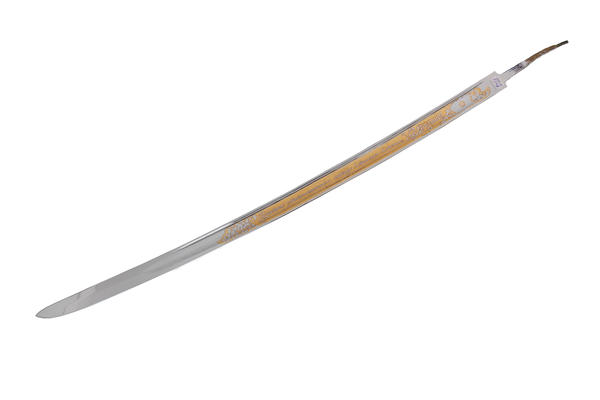During the Soviet times, the Zlatoust Arms Factory changed the subject matter, that was engraved on its steel products. In addition, household items became the main line of production. So, in the 1920s and 1930s, the workers of the factory mostly decorated hatchets, paper knives, cutlery, and personalized gift weapons.
The era of revolutionary upheavals made a strong impact on the decoration. The decorative patterns were superseded by industrial landscapes and portraits of the leaders. During the Great Patriotic War, the art department restored the production of bladed weapons. Sabers, daggers, and dirks, decorated by the artists of Zlatoust, were given as a reward to the Soviet commanders for their achievements.
Often, factory workers, who went to the war, received parcels with cigarette cases, which were also made of Zlatoust steel and decorated with an etched pattern. This saber blade of the 1927 model is one of the best examples of the decorated weapons of the Zlatoust Arms Factory of the Soviet period. It is also a relic of the Great Patriotic War.
The blade is a copy of the gift, which was made at the factory especially for Joseph Vissarionovich Stalin. The inscription indicating the fact was made on the right flat (side). The artisan Alexander Ivanovich Boronnikov etched, gilded and matted the background of the left flat, and created a relief image of a panorama of the Battle of Stalingrad, which was then plated with nickel.
The surface of the blade was carefully polished. The image on it is pretty clear. The panorama of the battle occupies the entire space. Flying squadrons launch an attack in the sky. On the ground, an unstoppable wave of huge tanks crushes everything in its way. Daring cavalry rushes toward the enemy, their blades shining and cloaks fluttering. A burst of fire comes from the artillery. The whole image is very expressive. The drawing manner is not perfect, nevertheless, the artist managed the task. He vividly depicted the punishing power and the irrepressible will to win.
The era of revolutionary upheavals made a strong impact on the decoration. The decorative patterns were superseded by industrial landscapes and portraits of the leaders. During the Great Patriotic War, the art department restored the production of bladed weapons. Sabers, daggers, and dirks, decorated by the artists of Zlatoust, were given as a reward to the Soviet commanders for their achievements.
Often, factory workers, who went to the war, received parcels with cigarette cases, which were also made of Zlatoust steel and decorated with an etched pattern. This saber blade of the 1927 model is one of the best examples of the decorated weapons of the Zlatoust Arms Factory of the Soviet period. It is also a relic of the Great Patriotic War.
The blade is a copy of the gift, which was made at the factory especially for Joseph Vissarionovich Stalin. The inscription indicating the fact was made on the right flat (side). The artisan Alexander Ivanovich Boronnikov etched, gilded and matted the background of the left flat, and created a relief image of a panorama of the Battle of Stalingrad, which was then plated with nickel.
The surface of the blade was carefully polished. The image on it is pretty clear. The panorama of the battle occupies the entire space. Flying squadrons launch an attack in the sky. On the ground, an unstoppable wave of huge tanks crushes everything in its way. Daring cavalry rushes toward the enemy, their blades shining and cloaks fluttering. A burst of fire comes from the artillery. The whole image is very expressive. The drawing manner is not perfect, nevertheless, the artist managed the task. He vividly depicted the punishing power and the irrepressible will to win.






